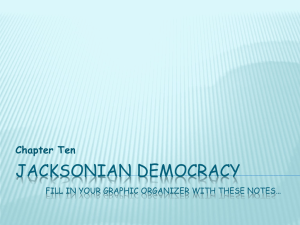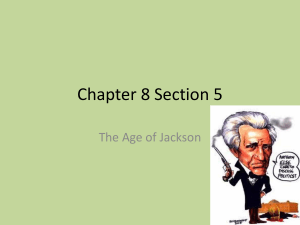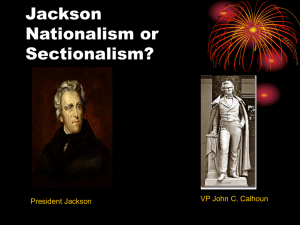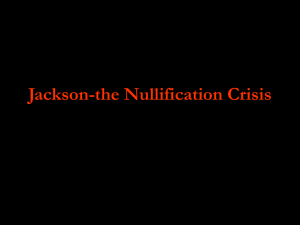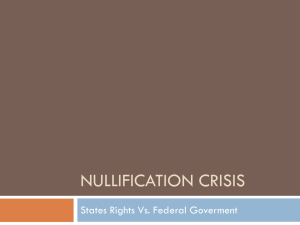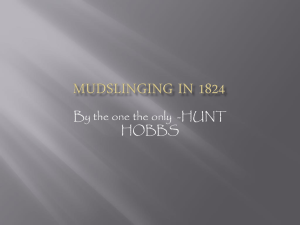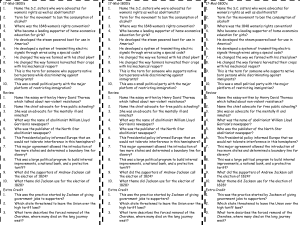States` Rights and the National Bank
advertisement
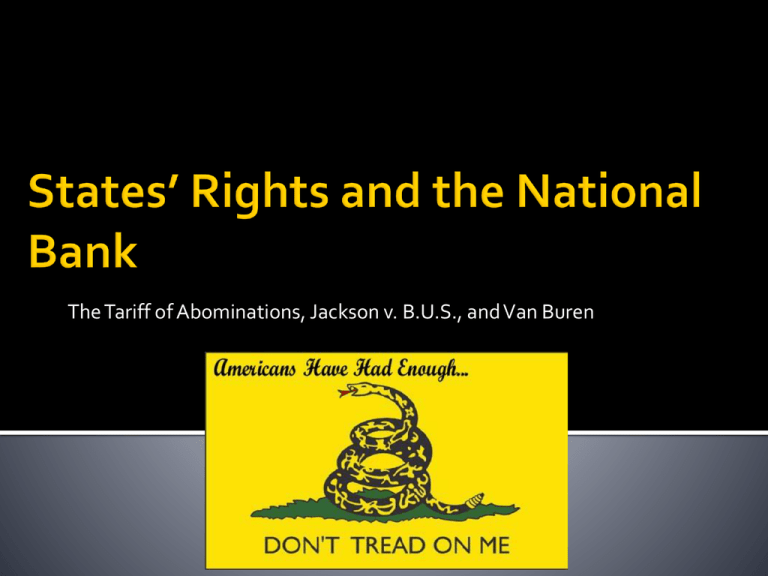
The Tariff of Abominations, Jackson v. B.U.S., and Van Buren After the War of 1812, British manufacturers tried to destroy American competitors by flooding the U.S. market with inexpensive goods. A protective tariff was passed in 1816 to protect our industry, and this was later increased in 1824 and 1828. By 1828, the tariff had reached such an exorbitant amount that it became known by many as the Tariff of Abominations. How did this tariff lead to major political debates, and what state took a personal stance against this tariff? John C. Calhoun, vice-president to Jackson, took a firm stance against the tariff due to its effects on SC, his home state. Even though he had rallied behind the American System which had proposed the tariff, the inflated rates pushed him to denounce it. ROBERT HAYNE (SC) DANIEL WEBSTER (MA) Believed the tariff would split the North and South. Also viewed the tariff as a destruction of the liberty of individuals. Supported the nullification theory, that was drafted by Calhoun, stating that the Constitution is based on a compact with the sovereign states and the government. Webster differed in his view of the tariff as a northerner. He viewed the nullification theory as an outright rebellion, and found that there is never a “middle road” between rebellion and compliance. His beliefs stemmed from seeing the need for the protection of the needs of the textile industry. The issue of states’ rights and nullification came to a head in 1832 when the Congress passed a new tariff that SC still did not find satisfactory. SC called the tariff “unauthorized by the constitution,” and “null, void, and no law.” They then threatened secession if customs officials tried to collect duties. What was Jackson’s response as a fellow southerner? Jackson was infuriated by SC’s actions and threatened to hang Calhoun and march federal troops into SC and enforce the tariff. He then passed the Force Bill in 1833 which allowed the federal government to use the army and navy against SC if they refused to pay. Henry Clay, the Great Compromiser, stepped in and proposed a tariff bill that gradually lowered duties over a ten-year period. Andrew Jackson began his attack on the BUS by vetoing the bill that was to recharter the bank. Henry Clay and Daniel Webster had hoped to diminish Jackson’s reputation by putting him at odds with the bank, but Jackson was a lot slyer than anticipated. Jackson depicted the BUS as a “privileged institution,” especially since all federal tax revenues were deposited in the BUS rather than state banks, and BUS stockholders, not tax payers, earned interest from these deposits. The Bank President, Nicholas Biddle, also came under scrutiny for giving loans to congressman at a much lower rate then what he gave to common citizens. Jackson used “pet banks,” (state banks loyal to the Democratic Party) to place all government funds. Jackson’s “pet banks” forced Biddle to scramble to save the B.U.S. He demanded immediate repayment of loans that were out and did not give out new loans, hoping that this would lead the frustrated people to recharter the bank. When businessmen traveled to Washington, D.C. to beg for the B.U.S. to be reopened, Jackson told them to, “Go to Nicholas Biddle.” Jackson successfully ended the Second Bank of the United States and another B.U.S. would not be opened for 73 years. His maneuvering had consequences and caused yet another rift in the political realm. Jackson had angered several people including some members of the Democratic Party. In 1834, those angered which included Clay, Adams, and Webster, formed the Whig Party. Whigs backed the American System, the use of federal money to construct roads and canals, and backed federal control of the banks and national currency. Martin Van Buren (Jackson’s V.P.) was chosen as the Democratic candidate when Jackson refused to run for a third term. With Jackson’s help, Van Buren easily won the election, but he inherited several issues caused by Jackson’s war with the B.U.S. The “pet banks,” where Jackson had deposited the money were known as “wildcat” banks since they printed large quantities of paper money. This money was not backed by gold or silver. People used this money to purchase land, therefore leaving the federal government with the problem. Jackson tried to stop this problem before leaving office by making an order that all land had to be made for with specie, or gold and silver. Banks were flooded with requests to cash in their paper money for specie. Banks had to suspend the redemption of bank notes. The collapse of hard currency led to bigger problems then expected in 1837 when we faced bank closings and the collapse of the credit system. The Panic of 1837 led to hundreds of businesses going bankrupt and more than 30% of the population becoming unemployed. Van Buren tried several strategies to reverse the effects of the panic, but they only worsened the effects of this economical crisis. Van Buren ran for reelection against Whig candidate William Henry Harrison. The Whig party portrayed Van Buren as a pampered aristocrat and Harrison as a common man. Harrison won and immediately began the Whig program to build the economy back up, but died a month later of pneumonia leaving his V.P., John Tyler in office. John Tyler was not a firm Whig supporter and was mainly put on the campaign as a way to get Southern votes. His term ended without much impact and he became known as “His Accidency” HW: Begin review packet, due for Thursday. If your 3rd set of Note Cards are not in by Friday, you will be on the Sunday Study Hall Note Card Corrections (if needed) are due Tuesday 18th. If you had a class job, bring your sheets to me to be signed. Have a great day!
